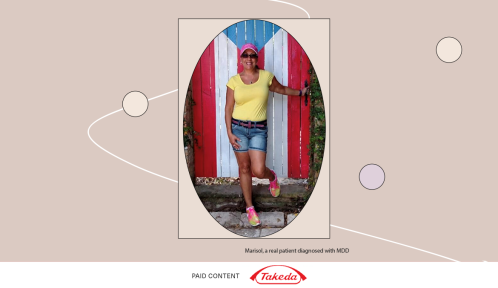Our editors independently select these products. Making a purchase through our links may earn Well+Good a commission
‘Habit Stacking’ Is the Simple Mind Trick for Making a New Routine or Ritual Stick
The concept of habit stacking refers to stacking a desired action on top of an existing habit. Here's why it can help with follow-through.

Starting a single new ritual or habit, whether it’s washing your face every night or taking a walk every afternoon, can feel daunting for many of us. And just forget starting a whole wellness routine. Mornings complete with journaling, meditating, and yoga before breakfast might as well be aspirational, reserved for only the most methodical among us…right? Well, not if you consider the basic premise of habit stacking, which says that you only need to find one thing you regularly do by default in order to build an entire tower of routine practices.
Experts in This Article
Melissa Ming Foynes, PhD, is a licensed clinical psychologist, international educator, holistic integrative wellness coach, and trauma-informed mindfulness, meditation and yoga teacher. Dr. Foynes has over 15 years of experience working with people coping with very human struggles: maintaining satisfying relationships, managing intense emotions and thoughts without feeling consumed by them, living in the present moment without being haunted by memories of the past or worries about the future, and arriving at a place where our lives are dictated by us and our values, rather than by traumas and other stressful life experiences.
Sekoul Krastev is a Co-Founder and Managing Director at The Decision Lab. A decision scientist with an MSc in Decision Neuroscience from McGill University, Sekoul’s work has been featured in peer-reviewed journals and has been presented at conferences around the world. Sekoul previously advised management on innovation and engagement strategy at The Boston Consulting Group as well as on online media strategy at Google. He has a deep interest in the applications of behavioral science to new technology and has published on these topics in places such as the Huffington Post and Strategy & Business.
Developed by self-help author S.J. Scott in his book Habit Stacking: 97 Small Life Changes That Take Five Minutes or Less, the concept of habit stacking is just what it sounds like. You identify any regular habit (which can be as small as brushing your teeth or closing your laptop at the end of a workday), and build a new habit on top of that existing habit. Think: “After I brush my teeth, I will wash my face.” Just like with an actual building, the stronger or more ingrained the foundational habit, the better you’ll be able to construct a new habit on top of it and secure it in place—at which point, you can add another on top of that one, and so on.
Though there aren’t direct studies on the efficacy of habit stacking, the work of behavior scientist B.J. Fogg, PhD, director of the Behavior Design Lab at Stanford University and author of Tiny Habits, has revved up support for the concept among academics, as has the work of productivity pro James Clear, author of Atomic Habits. And it makes sense that it’d be an effective technique, given that it’s a type of implementation intention, says clinical psychologist Melissa Ming Foynes, PhD. “In simple terms, an implementation intention is just a plan of when and where you will do something, like, ‘When I sit down at my desk in the morning, I’ll drink a sip of water.’”
“With habit stacking, the current habit becomes a cue to engage in the new action.” —Melissa Ming Foynes, PhD, clinical psychologist
Implementation intentions can help turn goals into automatic actions over time by creating a mental link between what you know or anticipate will happen (e.g., sitting at your desk) and what you want to happen (e.g., drinking water). With habit stacking, you’re taking advantage of this capability by attaching a new action to any kind of current habit, no matter if it occurs at a specific time or location, says Dr. Foynes. “This way, the current habit becomes a cue to engage in the new action.” And eventually, you’ll start doing the second action as habitually as the first.
Why does habit stacking help you adopt new habits?
The everyday habits that you do almost automatically—like making coffee or sending a particular email—become that way through a particular kind of brain chemistry. The different parts of your brain that have to fire for those actions to happen start to work together very quickly and efficiently, says Dr. Foynes. Tacking a new practice onto this already-strong, habitual neural network may fast-track your brain’s adoption of it. “Old habits are ingrained in our brains and likely represent really good entry points or ‘triggers’ for new ones to be built,” says behavioral scientist Sekoul Krastev, MSc, co-founder and managing director at The Decision Lab.
In this way, habit stacking basically tricks your mind into adopting a new habit by using an existing neural pathway. That may be why implementation-intention tactics of this sort have been shown to be more effective than simply intending to achieve a goal. In the latter case, you’d be relying on “willpower, grit, or motivation alone, all of which can be fleeting and vulnerable to stress, fatigue, and other external factors,” says Dr. Foynes.
There’s also something to be said about the rhythm of a new action flowing directly from the habit upon which it’s stacked. “If you have to stop what you’re doing to start your daily meditation in the afternoon, and then stop what you’re doing again later in the day to do 10 pushups, you’ve incurred two ‘starting costs,’” says Krastev, referring to the daunting difficulty of starting something new. But if you stack these things together, the starting cost is shared between them and thus reduced for each, he says. From the meditation, you can flow right into the pushups and don’t need to consciously stop doing something else.
What to consider when stacking a new action on top of a habit
Specificity
Specific actions are always better suited for a habit stack so that your brain can both spot the old habit easily and know exactly how to act on the new one in response.
“For example, rather than, ‘After my kids are in bed for the night, I’ll meditate for five minutes,’ you might go for something like, ‘After I kiss my kids good night and shut the door, I’ll meditate in my room for five minutes,’” says Dr. Foynes. “At first glance, ‘After my kids are in bed’ may seem specific enough, but it still raises questions, like ‘What happens if they don’t fall asleep right away? Or, what if they come out to get you?’” The idea is to reduce as much ambiguity as possible, and shrink the potential time between when you finish the existing habit and engage in the new behavior.
Brevity
Stack too involved or lengthy an action on top of an existing habit, and it’s bound to come tumbling down, no matter how stable the original habit. That’s why Dr. Foynes suggests starting with a version of the new action that is very brief (no more than two to five minutes) in order to better guarantee it’ll stick, and then building from there.
For instance, if your habit-stacking plan is to exercise for 30 minutes each morning after you finish your morning tea, you’ll probably be tempted to forgo the exercise if you’re running late or didn’t sleep enough the night before, she says. “If, instead, you say, ‘I’ll do 10 push-ups after I finish my cup of tea,’ that’ll feel much more doable. And as the 10 push-ups become habitual, you can then stack another habit on top of that, like jogging in place for 30 seconds, and so on.” Basically, baby steps are a more sure path to the top of a stack than huge leaps.
For much the same reason, you also don’t want to stack a bunch of new actions on top of a single habit at once. That introduces a lot of friction around an old habit, says Krastev, which can be just as destabilizing as going for a single huge new action. “For example, you might have the habit of doing a Duolingo exercise in the morning, so you try to stack meditation after it, and that works fine,” he says. “But then, you stack a short workout on top of that, as well, and the total friction makes the entire habit-stack fragile, so you start skipping even your Duolingo because you’re dreading the workout to follow.” Instead, stick to a single small new thing at one time.
Attainability
Though brevity can inherently make a new task more doable, it’s also worth considering other elements of general attainability before you go stacking away. Dr. Foynes offers the example of being a night person, but planning to create a habit stack by adding something to your morning routine—which probably won’t be effective if you can barely squeeze in the morning stuff as is. The same goes for attaching a habit to something that’s volatile, like the bedtime of a kid who often struggles to fall asleep. Instead, look for the existing habits of yours that are most ingrained and most consistently doable to ensure that anything you stack on top will be doable, too.
Dr. Foynes also suggests developing a contingency plan—because sometimes unexpected stuff happens that can get in the way of even the most attainable habit stack. “For example, if my goal is to meditate for five minutes after I brush my teeth at night, but on some nights, I feel so tired that I can’t seem to focus, perhaps my contingency plan is to take three deep, mindful breaths before I go to sleep,” she says. While it’s not the exact habit, it’s close enough that your brain can still draw the connections between teeth-brushing and a mindful activity to follow, in this case.
Similarity
If you’ve ever completely switched gears from one task to another or gotten distracted by something unrelated to what you were doing, you already know how the brain naturally prefers to focus on one thing at a time. That’s why habit stacking should generally stick to one topic area, too.
“It’s likely easier to stack together habits that have something to do with each other—like doing pushups with meditating, if they both make you feel more calm and empowered when you start your day—as opposed to stacking unrelated things, like making coffee and reading a book,” says Krastev. The more similar the items in your stack, the more likely you are to move seamlessly from one to the next until the whole thing is routine.










